M
Leave a Legacy of Giving
You can support our mission of changing lives by saving sight in multiple ways!
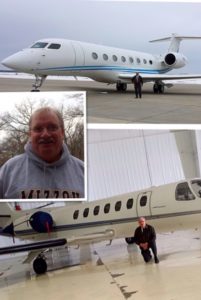

Laren from Missouri received a cornea transplant so he could keep flying planes.
Pilots undergo regular medical exams to retain their eligibility to fly, and a major component of that exam is the vision test. They must be able to see 20/20 with correction. Laren from Loose Creek, Missouri was told by his optometrist that he would someday need corneal transplants to repair his eyesight, so when Laren could no longer pass his pilot medical certification, he knew it was time to undergo surgery. “I just couldn’t give up flying,” Laren said. “At some point, this transplant would need to be done anyway so I said yes, and I was in the surgeon’s office a week or two later to do the procedure.”
Laren is semi-retired at this point and now flies corporate jets part-time. His vision was always a problem for him – he suffers from cataracts and Fuchs’ dystrophy – but he’d always been able to correct his vision to the level necessary for flight. In early October 2013, Laren was told he could no longer pass the vision portion of the exam, and his optometrist referred him to Dr. Luetkemeyer in Jefferson City. Dr. Luetkemeyer performed the surgery on Laren’s right cornea, and thanks to advances in surgery techniques, Laren was able to walk out of the office two hours later and pass his pilot’s medical exam eight weeks later in December. “I didn’t realize it would be such an easy procedure,” he said. “It’s amazing how much clearer things are and how they look after that transplant.”
Laren has said that his transplant experience made him more aware of eye, organ, and tissue donation. “I’ve always wanted to be a donor,” he said, “but when you get the impact of it on this side, it’s unbelievable. Everybody should be a donor, everybody.” And he’s also very thankful to the person who made the
selfless decision to donate the cornea he received. “The flat-out experience of being a recipient of a donor, knowing what someone else has done and how it affects you, sheds a whole new light on donation,” Laren said. “Especially for me. Eyesight is one of the most critical things when you crawl in the cockpit. Your eyesight has to be very, very good. So I can’t express enough thanks.”
With renewed vision and medical clearance to fly, Laren was back in the air for his first post-transplant flight in January. “It was just unbelievable,” he recalled. “Especially at altitude it can be so clear anyway. There was just day-and-night difference, what you can see, other airplanes, seeing the ground from 40,000 feet. I’m so thankful that I’m able to keep flying, something I love to do. I’m able to keep flying these jets. So I can’t express enough thanks to the donor who returned my sight.”
Join Laren and the millions of Americans who have declared their choice to be eye, organ, and tissue donors by signing up for the donor registry at the Donate Life America website or the local Department of Motor Vehicles office.
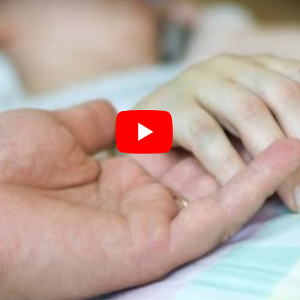
In April 2013, Saving Sight shared a story about Arnold, a happy-go-lucky man who donated his corneas to give the gift of sight to others. Arnold was a long-haul truck driver from Maine who passed away while in Springfield, Illinois for work, and his wife, Marie, supported his decision to become a donor, even though she was hundreds of miles away. “Following through with his wish to be a donor was never a hesitation in my shock and grief,” she said.
After the donation, Marie corresponded with one of the recipients of Arnold’s corneal tissue and learned a lot from the experience. She had this to share: “[Donation] isn’t just something you do – it’s life-changing for the recipients and the people who are left behind. Science gives us the technology to make these gifts happen, but without people giving so unselfishly, we could not bring about the life-changing results I have witnessed firsthand.”
Recently, Vince Dixon, a family friend of Marie, was touched by the stories of Arnold and other donors. And he decided to honor them and draw attention to the importance of donation by writing an original song, “Heart of a Hero,” which he then posted as a video to YouTube. Arnold is prominently featured in the video, starting at one minute and thirty seconds and at the end. Watch and listen to “Heart of a Hero” below to see the lasting impact Arnold has had as a donor.
Watch family friend Vince Dixon’s video tribute to Arnold and other donors featuring his original song, “Heart of a Hero.”
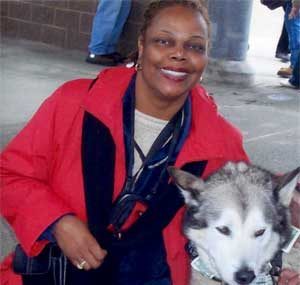

Patricia, a retired veteran from the St.
Louis Metro area, was completely blind until she received a cornea transplant.
Patricia, a veteran from Fairview Heights, Illinois, has experienced serious vision problems her entire life, including glaucoma, cataracts, and keratoconus. Keratoconus, according to the National Keratoconus Foundation, “is a non-inflammatory eye condition in which the normally round dome-shaped cornea progressively thins, causing a cone-like bulge to develop.” The disease is rare, affecting 1 in 2,000 people, but it significantly impairs vision, and its cause remains unknown. In 2002, Dr. Gans in St. Louis performed two corneal transplant surgeries on Patricia, which restored her vision. “In the left eye, I had already lost almost all my vision, but we had the transplant to keep the eye healthy,” Patricia explained. “In the right eye, though, from 2002 until May 2013, my vision was wonderful.” She enjoyed healthy vision and an independent life except for driving, which she couldn’t do because of reduced peripheral vision and depthperception. Patricia describes this period as “smooth sailing,” but she admits that it was bittersweet. “I was very happy to get the transplants – grateful that the donor families’ hearts were big enough to give me that wonderful gift – but my heart broke a bit because I knew what sacrifices they had to give,” she said.
Despite a lifetime of vision problems, Patricia was able to pursue a successful career. She served on active duty in the United States Air Force for more than 23 years, working in intelligence and security, before retiring from Scott Air Force Base. “When my son started high school,” she explained, “I promised him he could graduate from that school, so I retired.” Afterward, she worked ten more years as a juvenile probation officer in St. Louis’ Metro East region and retired for good in 2005.
In May 2013, however, Patricia fell face-first onto concrete, knocking loose her cataract implant and damaging the cornea transplant she’d received in her right eye. With the left eye effectively blind, the fall on her right side was debilitating – it left her completely blind. Her face and eye were too damaged from the fall to replace the cornea transplant right away, so she spent most of the summer and early autumn in the Central Blind Rehabilitation Center at Edward Hines, Jr. VA Hospital in Hines, Illinois. In that facility, Patricia learned how to live an independent life in spite of blindness. “They gave me all the tools so I could remain independent,” she said.
In November 2013, Patricia was finally eligible to receive a cornea transplant in her right eye, which rescued her from more than five months of total blindness. “My confidence is getting back to where it’s supposed to be. I’m just kind of the happy go lucky person I was,” she said. “I can sew a little bit, for short periods of time. When I go shopping, I am now able to see the brands. I used to have others help me find things. Now I can do more for myself.” As Patricia’s vision continues to improve, she’ll be able to pursue some of her favorite pastimes: spending time with family, quilting, bowling, reading, and traveling to visit her close military friends across the country. “I look forward to the future of doing the things I used to be able to do,” she said.
Patricia’s experiences have taught her many things. “Be a part of the donor registry,” she suggested. “And make regular appointments to see your eye doctor. It is very important to keep the eyes healthy.” Thanks to her optimism, supportive medical care, her donor families, and following her doctor’s instructions, Patricia is on the road to enjoying her retirement with clear vision.
To join the millions of Americans who have declared their choice to be eye, organ, and tissue donors, sign up for the donor registry at the Donate Life America website or the local Department of Motor Vehicles office.
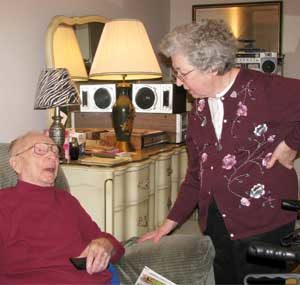

Sister Teresa is able to continue serving her community thanks to corneal transplantation.
Before she retired, Sister Teresa of Benton, Kentucky taught elementary school for twenty years. And after that, she worked in two different positions in university administration before she moved to parish ministry at a small church in western Kentucky. But despite having such an extensive career, she has always had problems with her vision. “Growing up, sunlight always bothered me,” she said. “We would be out in the front yard getting pictures on Sunday with company over, and they’d say, ‘Open your eyes!’ I didn’t think anything of it. But later on, when I became a teacher, I didn’t realize that I should be able to see the facial expressions of kids in the back of the room.”
When Sister Teresa began to get headaches, an optometrist prescribed glasses for nearsightedness, which fixed the problem. She didn’t experience difficulties after that, but when her optometrist retired, he said he’d been watching her for Fuchs’ dystrophy, a hereditary disease that causes the corneas to deteriorate. “He said eventually I will probably need a cornea transplant,” she said. “In my mind, I thought, no eye surgery for me, but I didn’t say that.” Sister Teresa was hesitant to get eye surgery because one of her uncles lost his sight in one eye due to complications during surgery. She got a second opinion from an ophthalmologist, though, who agreed with the diagnosis of Fuchs’ dystrophy and also diagnosed a cataract in the left eye. “I decided I could get along as I was, but I knew my vision, especially in the left eye, was getting worse,” said Sister Teresa. Eventually, she had the cataract removed and a laser treatment on her left eye, but neither restored her vision.
Five to six years later, after she retired, Sister Teresa could no longer drive because of her vision, so her friend John offered to drive her to see Dr. Berdy in St. Louis. Dr. Berdy is a corneal surgeon who also serves as one of the Medical Directors for Saving Sight. “He was very, very encouraging,” Sister Teresa reported. After a consultation, she agreed to transplant surgery, and in the course of two years, she received two transplants and had another cataract removed. “So now my vision is so good, I’m often overwhelmed at how well I can see compared to before,” she said, adding that she can now drive and read easily again. “It’s a modern miracle,” she said. “I’m very grateful to God and Saving Sight and the donors for providing the corneas, and Dr. Berdy who has done such a marvelous job. And to my friend John and to many people who supported me, prayed for me, and helped me through all of this.”
Sister Teresa has enjoyed corresponding with the family of one of her donors. After writing a letter of thanks to the donor family, “I got a beautiful letter from the sister of the woman whose cornea I have in my left eye,” she said. “She said how grateful she was that her sister’s cornea helped someone else. She knew her sister would be pleased to know that.”
Despite her initial concerns, Sister Teresa is enthusiastic about her transplant experience. “Nobody can guarantee that it’s going to be successful,” she said, “But I’ve had great success with the surgery, like many others. For now I have such wonderful vision.” These days, Sister Teresa takes communion to people in assisted living facilities and people who can’t leave their homes, serving as a Catholic presence in Benton, a town without its own Catholic church. In addition, she prepares and serves meals in a local soup kitchen. “It’s a full schedule for me,” she said. Sister Teresa makes the most of her new, wonderful vision by putting it to use as a volunteer in her community.
To join the millions of Americans who have declared their choice to be eye, organ, and tissue donors, visit the Donate Life America website or the local Department of Motor Vehicles office.
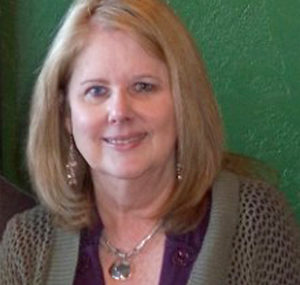

Patti was losing her vision to Fuchs’ dystrophy until she received two cornea transplants that saved her sight.
“Colors are brighter, more vibrant,” said Patti, a nurse from Overland Park, Kansas, about her vision after cornea transplantation. “The first thing I noticed was the colors. Everything was just so much brighter, the beautiful colors. Before I was seeing them, but everything looks better after the surgery.”
Before her transplants, Patti suffered from cataracts and Fuchs’ dystrophy, a hereditary disease in which corneal cells die, causing vision to decrease as fluid builds up in the cornea. Eventually, her vision was so bad she couldn’t see street signs, and her eye doctor treated her for cataracts in 2007. She received intraocular lens implants, which improved her vision somewhat, but it didn’t solve the problem. Patti had not heard of Fuchs’ dystrophy until her son was diagnosed with it during grand rounds at the University of Kansas Medical Center. “At this point, the whole family has been diagnosed with Fuchs’ except my two older sisters and my brother,” said Patti. The disease runs in families, affecting approximately 4 percent of people over age 40, according to the National Institutes of Health. Patti’s nephew has received corneal transplants to restore his vision, and her son will likely undergo transplantation as well to restore his vision.
Patti was able to make do with her reduced vision for many years, but in 2012, she was in a car accident caused by a drunk driver, sustaining injuries to her face and head. Upon seeing her swollen face, Patti visited her eye doctor for an examination to make sure the accident had not injured her eyes, too. It was during this check-up that he advised Patti to undergo transplantation to restore her sight. She received a corneal transplant in each of her eyes in September and November of 2012. “I wasn’t feeling very scared,” Patti said of the procedure. “As a nurse, I kind of knew what would happen. You’re awake, but you feel secure. The procedure was pretty painless.” Patti was eligible to receive donor tissue processed for DSAEK, which helps reduce the recovery period by being less invasive. “You don’t have any vision for three days after the transplant,” she reported. “But I had friends who know I like to read—they came over and read to me. They gave me books on tape to listen to also.”
The surgeries were successful. Now, with clear vision, Patti is better able to work, drive safely, and complete the tasks of everyday life. “Night driving is still kind of an issue with depth perception, but I feel really lucky to have gotten these corneas so I can continue to live,” she said. “I live by myself so if I lost my eyes, I’d be a mess. How would I buy groceries or pay my bills? You start thinking about all of these things, and so if you can help somebody else, you should.” Patti reports that she is registered to be an organ, eye, and tissue donor. “I encourage people to sign up for the registry,” she said. “You can change someone’s life.”
Patti’s life has changed for the better. She’s back to enjoying her favorite pastimes. “I’m much better at tennis than I used to be,” she reported. “I’ve noticed that. I enjoy the outdoors – tennis, bicycling—and I’m in a singles group. I also enjoy reading, TV, movies—all things that require sight, actually.
You can changes lives by joining the millions of Americans like Patti who have declared their choice to be donors. Visit the Donate Life America website or a local Department of Motor Vehicles office to register.